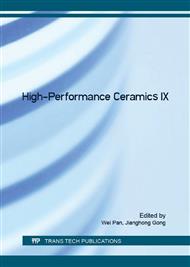[1]
N.D. Ruse, and M.J. Sadoun, Resin-composite Blocks for Dental CAD/CAM Applications, Journal of Dental Research. 93 (2014) 1232-1234.
DOI: 10.1177/0022034514553976
Google Scholar
[2]
P.F. Manicone, P. Rossi Iommetti, and L. Raffaelli, An overview of zirconia ceramics: Basic properties and clinical applications, Journal of Dentistry. 35 (2007) 819-826.
DOI: 10.1016/j.jdent.2007.07.008
Google Scholar
[3]
A. Coldea, M.V. Swain, and N. Thiel, Mechanical properties of polymer-infiltrated-ceramic-network materials, Dental Materials. 29 (2013) 419-426.
DOI: 10.1016/j.dental.2013.01.002
Google Scholar
[4]
I. Thornton, Mechanical properties of dental resin composite CAD/CAM blocks, University of British Columbia, (2014).
Google Scholar
[5]
J. Nguyen, V. Migonney, N.D. Ruse, and M. Sadoun, Properties of experimental urethane dimethacrylate-based dental resin composite blocks obtained via thermo-polymerization under high pressure, Dental Materials. 29 (2013) 535-541.
DOI: 10.1016/j.dental.2013.02.006
Google Scholar
[6]
L. He, D. Purton, and M. Swain, A novel polymer infiltrated ceramic for dental simulation, Journal of Materials Science: Materials in Medicine. 22 (2011) 1639-1643.
DOI: 10.1007/s10856-011-4350-3
Google Scholar
[7]
A. Della Bona, P.H. Corazza, and Y. Zhang, Characterization of a polymer-infiltrated ceramic- network material, Dental Materials. 30 (2014) 564-569.
DOI: 10.1016/j.dental.2014.02.019
Google Scholar
[8]
A.C. Johnson, A. Versluis, D. Tantbirojn, and S. Ahuja, Fracture strength of CAD/CAM composite and composite-ceramic occlusal veneers, Journal of Prosthodontic Research. 58 (2014) 107-114.
DOI: 10.1016/j.jpor.2014.01.001
Google Scholar
[9]
S. Lauvahutanon, H. Takahashi, M. Shiozawa, et al, Mechanical properties of composite resin blocks for CAD/CAM, Dental Materials Journal. 33 (2014) 705-710.
DOI: 10.4012/dmj.2014-208
Google Scholar
[10]
M.V. Swain, A. Coldea, A. Bilkhair, and P.C. Guess, Interpenetrating network ceramic-resin composite dental restorative materials, Dental Materials. (2015).
DOI: 10.1016/j.dental.2015.09.009
Google Scholar
[11]
N.B. Cramer, J.W. Stansbury, and C.N. Bowman, Recent Advances and Developments in Composite Dental Restorative Materials, Journal of Dental Research. 90 (2011) 402 -416.
DOI: 10.1177/0022034510381263
Google Scholar
[12]
J.L. Ferracane, Resin composite—State of the art, Dental Materials. 27 (2011) 29-38.
Google Scholar
[13]
R.L. Sakaguchi and J.M. Powers, Chapter 11: Restorative Materials: Ceramics. in: R.L.S.M. Powers (Ed. ), Craig's Restorative Dental Materials (13th Edition), Mosby, Saint Louis, 2012, pp.253-275.
DOI: 10.1016/b978-0-323-08108-5.10011-8
Google Scholar
[14]
S. Klapdohr, and N. Moszner, New Inorganic Components for Dental Filling Composites, Monatshefte für Chemie / Chemical Monthly. 136 (2005) 21-45.
DOI: 10.1007/s00706-004-0254-y
Google Scholar


